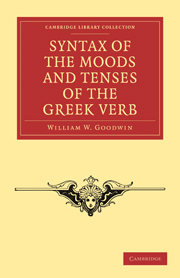Book contents
- Frontmatter
- PREFACE TO THE SECOND EDITION
- Contents
- CHAPTER I GENERAL VIEW OF THE MOODS
- CHAPTER II USE OF THE TENSES
- CHAPTER III THE PARTICLE ῞AN
- CHAPTER IV USE OF THE MOODS
- CHAPTER V THE INFINITIVE
- CHAPTER VI THE PARTICIPLE
- CHAPTER VII VERBAL ADJECTIVES IN -τέος
- APPENDIX I
- APPENDIX II
- INDEX TO EXAMPLES
- ENGLISH INDEX
- GREEK INDEX
CHAPTER IV - USE OF THE MOODS
Published online by Cambridge University Press: 07 September 2011
- Frontmatter
- PREFACE TO THE SECOND EDITION
- Contents
- CHAPTER I GENERAL VIEW OF THE MOODS
- CHAPTER II USE OF THE TENSES
- CHAPTER III THE PARTICLE ῞AN
- CHAPTER IV USE OF THE MOODS
- CHAPTER V THE INFINITIVE
- CHAPTER VI THE PARTICIPLE
- CHAPTER VII VERBAL ADJECTIVES IN -τέος
- APPENDIX I
- APPENDIX II
- INDEX TO EXAMPLES
- ENGLISH INDEX
- GREEK INDEX
Summary
This chapter includes all those constructions which require any other form of the finite verb than the simple Indicative expressing an absolute assertion (§ 2). The Infinitive and Participle are included here only so far as they are used in indirect discourse, or in Protasis and Apodosis.
These constructions are divided into the following classes:–
I. Final and Object Clauses after ἵνα, ὡς, ὅπως, ὄφρα, and μή.
II. Conditional Sentences.
III. Relative and Temporal sentences.
IV. Indirect Discourse, including Indirect Quotations and Questions.
V. Causal Sentences.
VI. Expressions of a Wish.
VII. Imperative and Subjunctive in Commands, Exhortations, and Prohibitions.
VIII. Subjunctive (like the Future Indicative) in Independent Sentences.–Interrogative Subjunctive.–Οὐ μή with the Subjunctive or Future Indicative.
SECTION I.
FINAL AND OBJECT CLAUSES AFTER ῞Ινα, ʿΩς, ῝Οπως, ῞Οφρα, AND Μή.
§ 43. The clauses which depend upon the socalled final particles, ἵνα, ὡς, ὅπως, ὄφρα, that, in order that, and μή, lest, that not, may be divided into three classes:–
A. Pure final clauses, in which the end, purpose, or motive of the action of any verb may be expressed, after any one of the final particles; as ἔρχεται ἵνα τοῦτο ἴδῃ, he is coming that he may see this; ἀπέρχεται μὴ τοῦτο ἴδῃ, he is departing that he may not see this.
- Type
- Chapter
- Information
- Syntax of the Moods and Tenses of the Greek Verb , pp. 65 - 187Publisher: Cambridge University PressPrint publication year: 2010First published in: 1867



